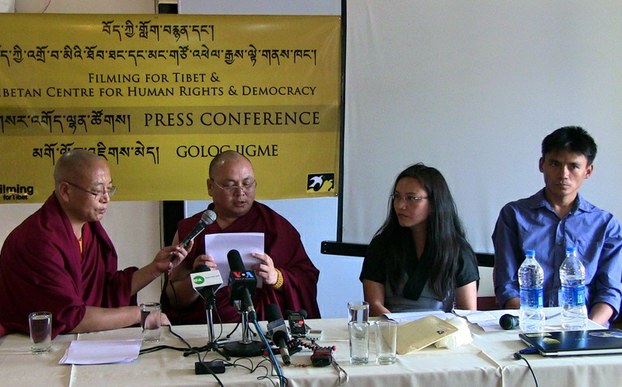




A Tibetan monk who miraculously escaped detention in China’s Gansu province and fled to neighboring India after trekking across mountains and forests said Wednesday that his spirit is unbroken though he was brutally tortured during his imprisonment.
Speaking to reporters on Wednesday for the first time since his May 18 arrival in Dharamsala, India, Golog Jigme Gyatso, 44, said he was taken into custody three times since 2008 because of his activities protesting Chinese rule.
He later managed to flee from a detention center near a Tibetan-populated area in Gansu province.
“While in detention, I was hung from the ceiling and tortured,” said Gyatso, who was recently hailed a “hero” by a global media group for helping to make a documentary film on the lives of Tibetans under harsh Chinese rule.
“I was severely tortured, especially during my seven months of detention in 2008, which really hurt my health,” he told RFA’s Tibetan Service separately. “The most painful part was when they hung me from the ceiling. They hung me up overnight, and I was beaten and tortured.”
The abuse he suffered in jail caused internal injuries, said Gyatso, whose detention stemmed from his role in helping to produce the film “Leaving Fear Behind.”
Addressing the press conference organized by Filming for Tibet, which produced the controversial film, and by the Dharamsala-based Tibetan Centre for Human Rights and Democracy, Gyatso said he had also suffered “broken ribs and damaged knees.”
Gyatso told RFA that he “managed to escape from the police detention center” where he was guarded by 16 policemen. He did not give details of how he slipped away from the detention facility.
“Even today, I continue to have severe pain on the backbone and ribs, and my knee dislocates whenever my body gets cold,” Gyatso said, according to a report by the Dharamsala-based Central Tibetan Administration (CTA), Tibet’s government in exile.
'Politically sensitive'
Gyatso, who was briefly detained for a second time in 2009 and later in 2012, was formerly a monk in Labrang monastery in Gansu province.
The 25-minute film he helped produce features interviews with Tibetans living in Tibet’s northeastern Amdo region and covers topics, including the 2008 Beijing Olympics and Tibetans’ reverence for exiled spiritual leader the Dalai Lama, considered politically sensitive by Chinese authorities.
Speaking in Dharamsala, Gyatso said that he escaped from his last detention, freeing himself from his shackles and walking through an open door, after learning of a plot by authorities to kill him in jail.
“For one year and eight months, I traveled in hiding across mountains, rivers, and forests in Tibet,” Gyatso said, adding that he heard following his escape that authorities had offered a 200,000 yuan [U.S. $32,082] reward for his capture after falsely accusing him of murder.
“I thought of self-immolating in protest against this baseless accusation, but then realized it would be more important to survive in order to serve the Tibetan cause,” he said. “So I changed my mind.”
Tibetan opposition to Beijing’s rule is now largely driven by Chinese criticisms of the Dalai Lama and by China’s refusal to allow him to return, Gyatso said.
“China also seeks to destroy the Tibetan language, tries to undermine Tibetans’ aspirations, and opposes and misrepresents Tibetan support of the Dalai Lama’s Middle Way Approach,” he said.
In what the Dalai Lama has called a Middle Way Approach to the problems of Tibet, the exiled spiritual leader and the CTA have accepted the region’s present status as a part of China, while urging greater cultural, religious, and political freedoms for the Tibetan people.
“These are the main reasons for fighting against China,” Gyatso said, adding that a majority of Tibetans in Tibet now protest “for the same reasons.”
Sporadic demonstrations challenging Beijing’s rule have continued in Tibetan-populated areas of China since widespread protests swept the region in 2008, with 131 Tibetans setting themselves ablaze in self-immolation protests calling for Tibetan freedom since February 2009.
Reported by Ugyen Tenzin for RFA’s Tibetan Service. Translated by Karma Dorjee. Written in English by Richard Finney.